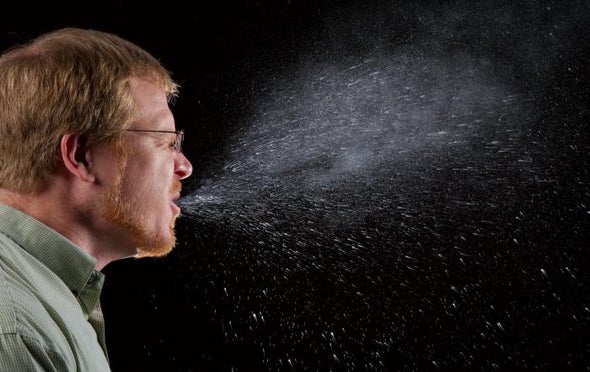(单词翻译:单击)
听力文本
This is Scientific American's 60-second Science. I'm Karen Hopkin.
You're at the supermarket trying to choose a ripe tomato when, behind you, you hear...
(CLIP: Cough sound)
If you're like most people, you probably hold your breath, tighten your mask and hope you don't catch whatever Patient Zero is spraying over the fresh produce. And if you're like most people, chances are you're overreacting, because a new study shows that we're not very skilled when it comes to diagnosing infectiousness based on the sound of a sneeze or cough. The work is in the Proceedings of the Royal Society: Biological Sciences.
Previous studies have shown that folks can tell when someone is sick based on how they look or, in some cases, how they smell. So it's only natural to wonder whether the same would hold true for an assessment with our ears.
So researchers asked volunteers to listen to audio clips of people hacking and sneezing.
"Half of the coughs and sneezes were produced by someone with an infectious illness, like the flu or the common cold. And half were produced by benign causes like eating too much cinnamon all at once or sticking a Q-tip up their noses."
Nicholas Michalak, a grad student in social psychology at the University of Michigan.

"We clipped these sounds from YouTube videos in which people told their audience that they were sick. Many reported having been diagnosed by a medical professional. All this said, we could not directly confirm whether people in our sound clips were infectious or not."
And what he found?
"Across four studies of over 600 participants in total, on average, people guessed four out of 10 sounds correctly, which is consistent with random guessing. In other words, they weren't very good at judging whether the sounds were infected."
But being bad judges didn't dampen their confidence. When asked how sure they were about their guesses, on a scale of 1 to 9, participants reported an average certainty of 7.
"Interestingly, we didn't find any evidence that people who were more certain about their guesses were more or less likely to guess correctly."
So what made them so sure that certain sounds were sure signs of disease? Well, the sickies, they figured, made noises that seemed the most gross.
"The more disgusting they perceived a sound, the more likely they were to judge it infectious, even if the sound wasn't infectious."
So...
(CLIP: Noninfectious cough sound)
...might be deemed more contagious than...
(CLIP: infectious cough sound)
...depending on your own personal nasty-o-meter.
All that's to say...
"Even if it seems you can tell whether a cough or sneeze is infectious, based on how disgusting it sounds, that feeling has the potential to mislead you."
In other words, you can't judge a bug by its cougher.
Thanks for listening for Scientific American's 60-second Science. I'm Karen Hopkin.
参考译文
这里是科学美国人——60秒科学。我是凯伦·霍普金。
你正在超市里努力挑选成熟的西红柿,突然你身后传来……
(音频片段:咳嗽声)
如果你和大多数人一样,你可能会屏住呼吸,按紧口罩,希望自己不会赶上零号病人正向生鲜产品喷洒病毒。如果你和大多数人一样,那你可能是反应过度了,因为一项新研究表明,我们不是很擅长根据喷嚏或咳嗽声来诊断传染病。这项研究发表在《英国皇家学会学报:生物学》上。
先前研究表明,人们可以根据外表——有时根据气味——来判断一个人何时在生病。因此,我们自然想知道,用我们的耳朵是否也能进行评估。
因此,研究人员让志愿者听人们咳嗽和打喷嚏的音频片段。
“其中一半的咳嗽和喷嚏声是流感或感冒等传染病患者发出的。另一半则因良性原因产生,比如一下吃太多肉杜或往鼻孔里捅棉签。”
密歇根大学社会的心理学研究生尼古拉斯·米恰拉克说到。
“我们从YouTube视频中截取了这些声音,视频中的人告诉观众他们生病了。许多人报告称经过了医学专业人员的诊断。尽管如此,我们仍然无法直接确认音频片段中的人是否具有传染性。”
他发现了什么?
“在总共600多人参与的四项研究中,人们猜测的正确率平均为40%,这与随机猜测正确率一致。换句话说,他们不太善于通过声音判断传染性。”
但判断力不佳并未打击他们的自信。当被问及对自己的猜测有大把握时,在1到9的范围内,参与者报告的平均确定度为7。
“有趣的是,我们没有发现任何证据表明,对自己的猜测更有把握的人,或多或少更容易猜对。”
那是什么让他们如此确信某些声音是疾病的明确信号呢?他们认为,病人发出的声音似乎是最恶心的。
“他们觉得声音越恶心,就越有可能判断声音有传染性,即使发出声音的人并没有传染病。”
因此……
(音频片段:非传染性咳嗽声)
……可能被认为比……
(音频片段:传染性咳嗽声)
更具传染性。
……这取决于你自己判断恶心的程度。
这一切表明……
“即使你似乎能根据声音的恶心程度来判断咳嗽或喷嚏是否具有传染性,这种感觉也有可能误导你。”
换而言之,你不能通过咳嗽来判断传染病。
谢谢大家收听科学美国人——60秒科学。我是凯伦·霍普金。
译文为可可英语翻译,未经授权请勿转载!
重点讲解
重点讲解:
1. hold one's breath 屏息;止住呼吸;
I held my breath and sank under the water.
我屏住呼吸沉入水底。
2. all at once 同时;一起;
It's a lot of information to absorb all at once.
要一下子消化这么多资料,真是很难。
3. be consistent with (观点等)一致的,吻合的,不矛盾的;
This result is consistent with the findings of Garnett & Tobin.
这个结果与加尼特托宾公司的调查结果一致。
4. depend on 取决(于);有赖(于);
The chances of a full recovery will depend on the severity of her injuries.
能否彻底康复取决于她受伤的严重程度。


